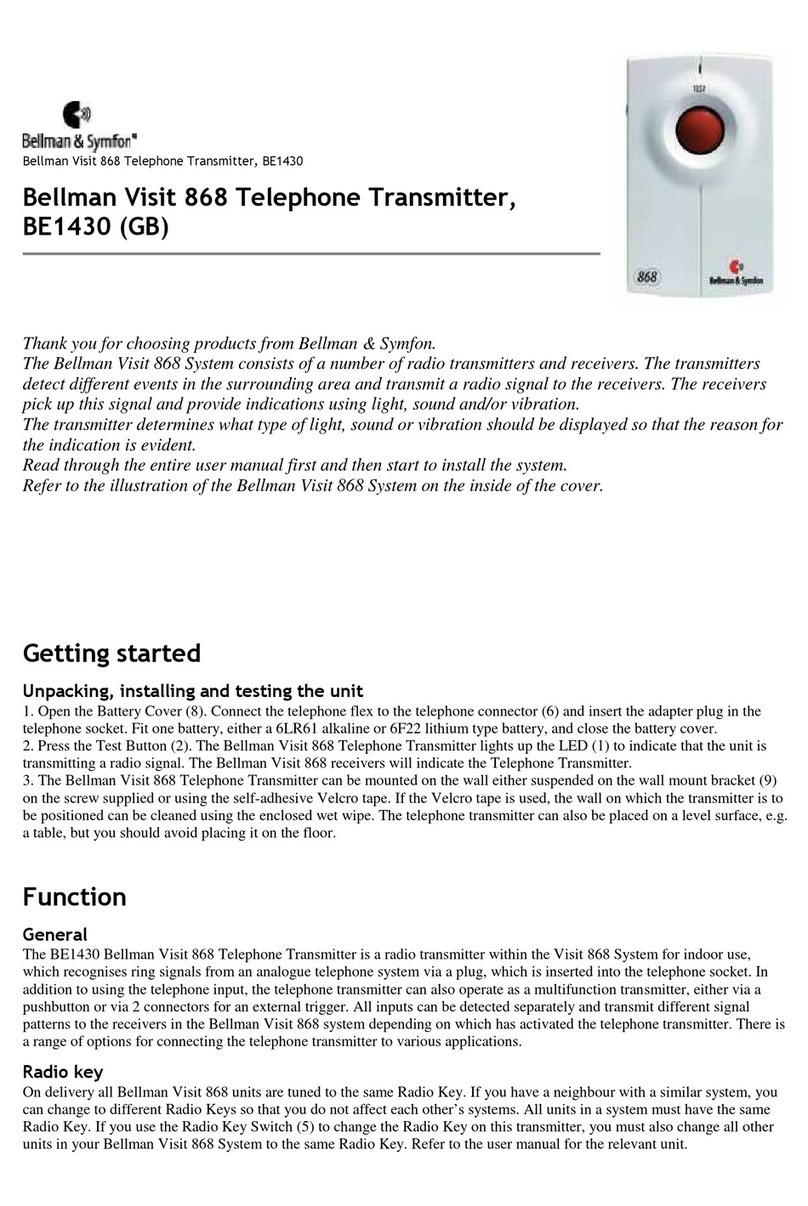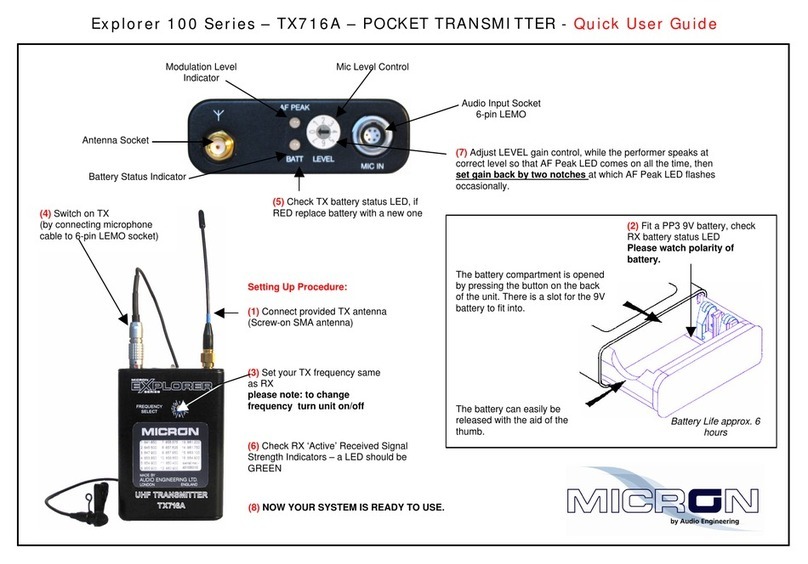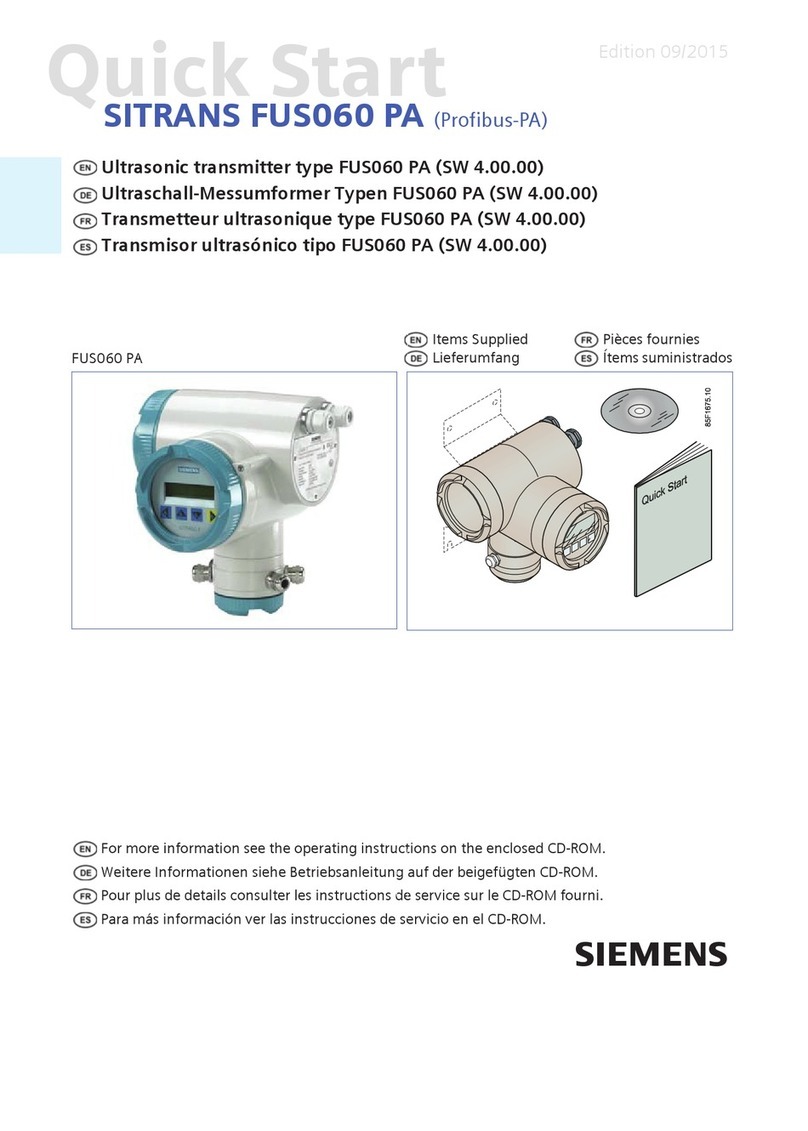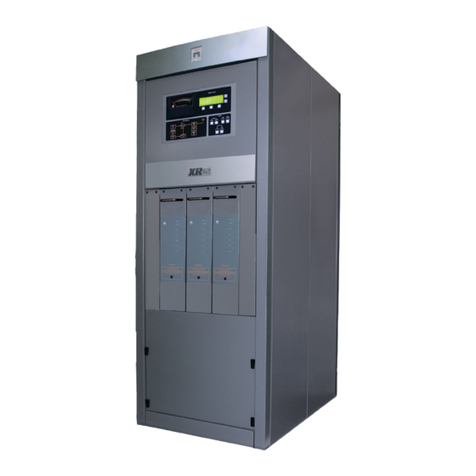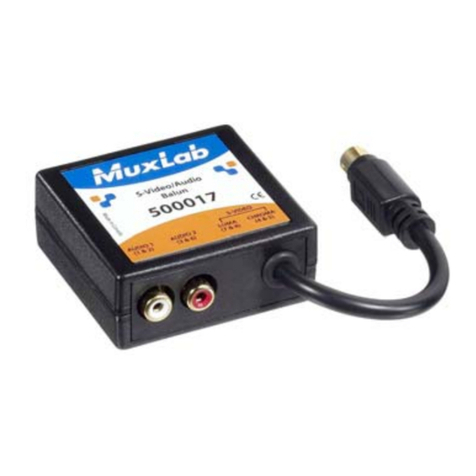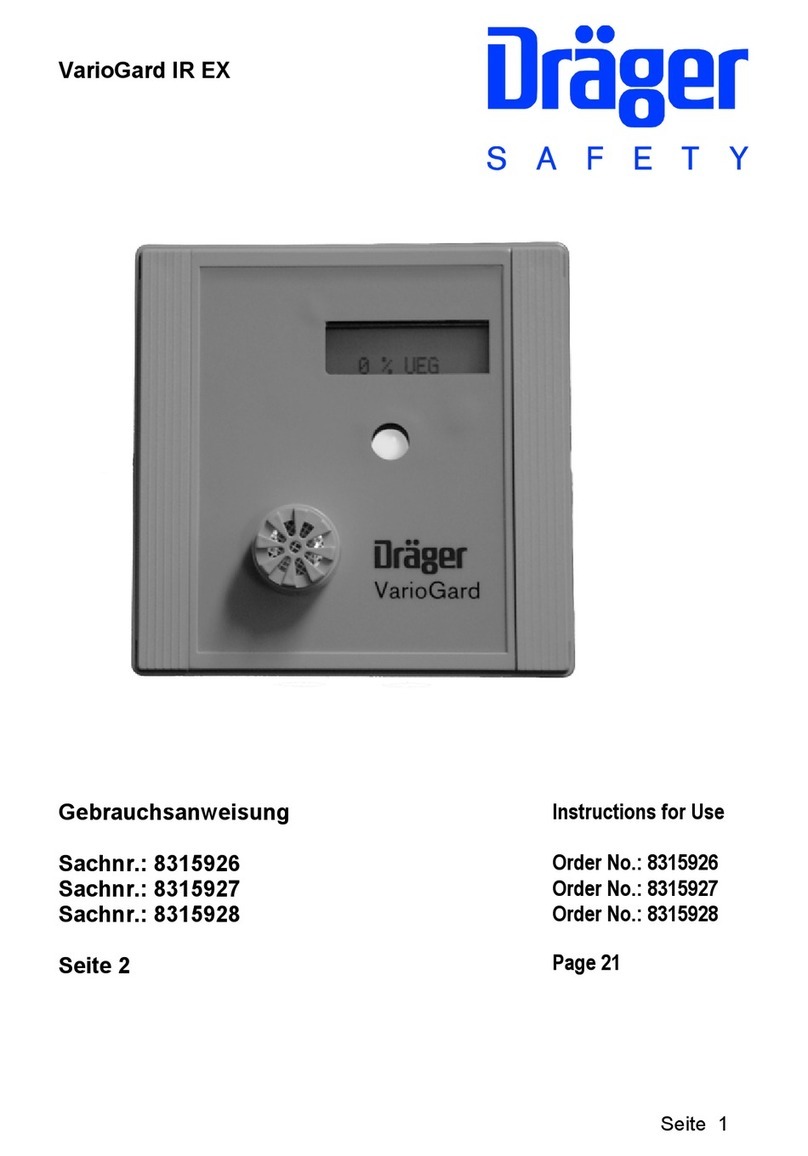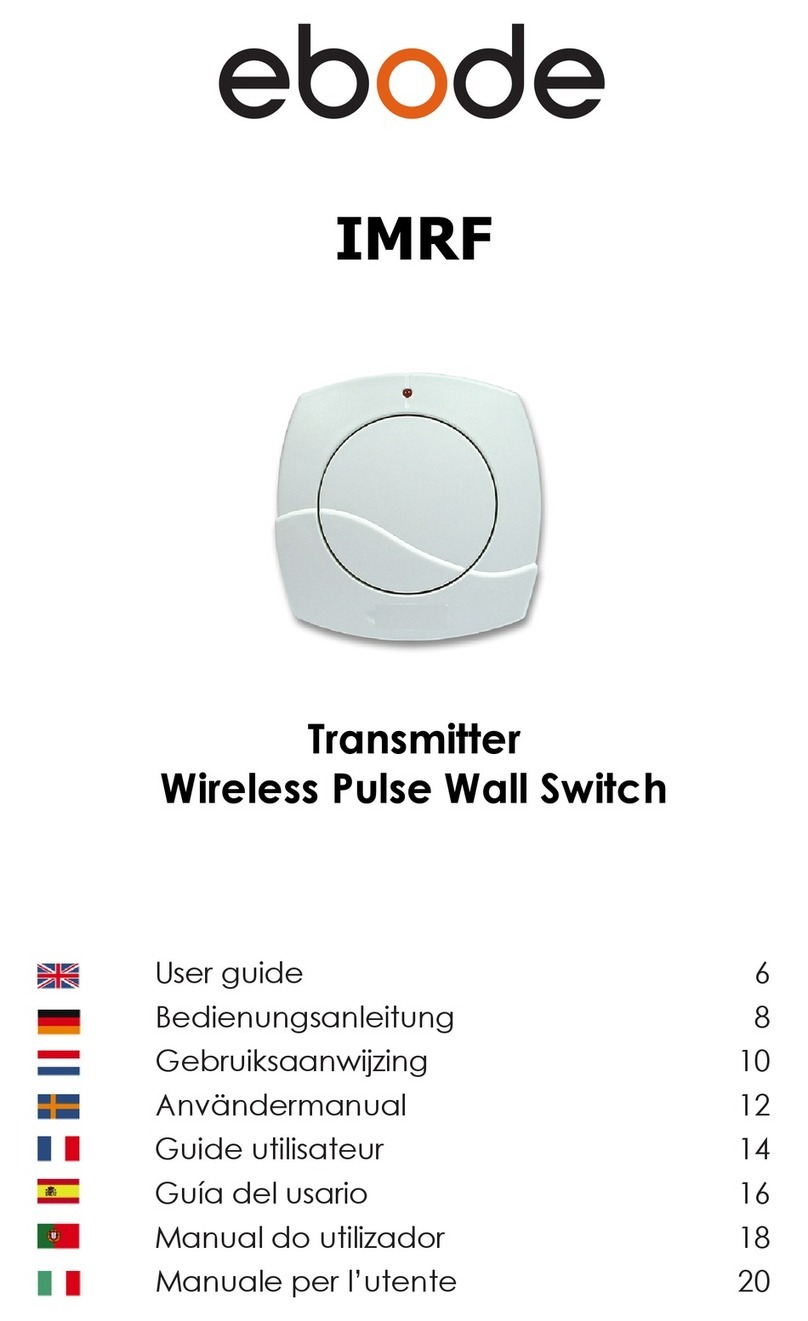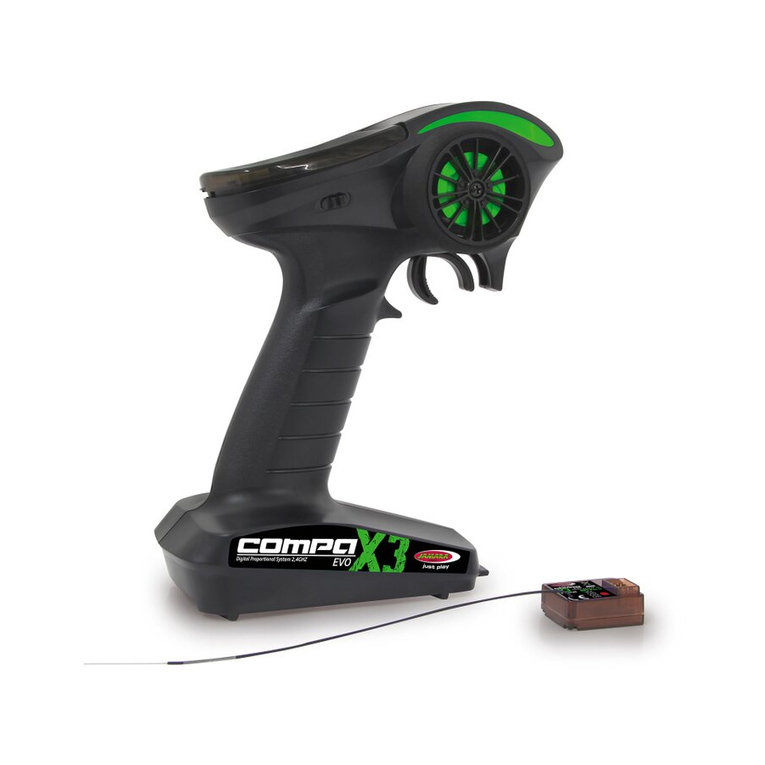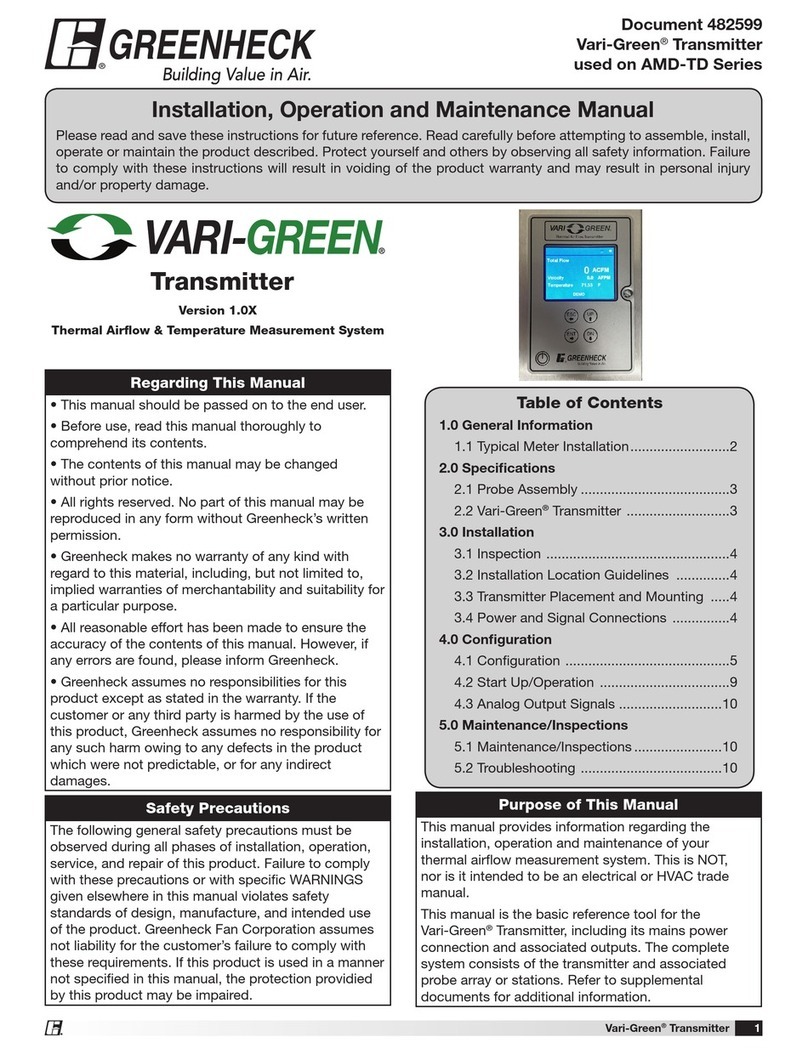Harmonic PWRLink II 4800T Series User manual

PWRLink™ II 4800T Series
Optical Transmitter
Product Manual
Manual Part No.: 700-0051934
Rev A
February 2002

PWRLink II 4800T Optical Transmitter Product Manual
Copyright © 2002 Harmonic Inc.
ATTENTION
AVERTISSEMENT
ACHTUNG
Pursuant to the pertinent sections of Title 21, (United States) Code of Federal Regulations
(CFR), Chapter I, Subchapter J, and administered by the Center for Devices and Radiological
Health (CDRH), operation under the Food and Drug Administration (FDA), this product,
which produces or receives an optical signal, composed of Laser Radiation, complies with 21
CFR Chapter I, Subchapter J, as applicable to Class I Laser Products with a Class 3B Hazard.
INTENDED MEANING
SIGNIFICATION
BEDEUTUNG
INTERNATIONAL SYMBOL
SYMBOLE INTERNATIONAL
INTERNATIONALES SYMBOL
DANGER:
Invisible Laser Radiation, when open or when operating with
fiber disconnected.
AVOID DIRECT EXPOSURE TO THE BEAM.
Never
operate unit with a broken fiber or with a fiber connector disconnected.
DANGER:
Les rayons laser sont invisibles à l´oeil. NE PAS S´EXPOSER
DIRECTEMENT AU FAISCEAU. Ne jamais utiliser l´appareil lorsque la
fibre est interrompue ou un connecteur endommagé ou déconnecté.
VORSICHT:
Unsichtbare Laserstrahlung, wennAbdeckung geöffnet oder
Glasfaserkabel entfernt. DIREKTEN KONTAKT MIT DEM STRAGL
VERMEDIDEN. Das Gerät nicht einschalten, wenn das Glasfaserkabel
beschädigt oder nicht angelchlossen ist.
CAUTION:
There are no user serviceable parts inside. Refer all servicing
to qualified service personnel. Other than those specific measurements,
adjustments and tests specified in the manual, make NO attempt to
modify or alter any circuit or assembly in any manner.
ATTENTION:
Toute intervention sur cet équipement est formellement
déconseillée par le fabricant. En dehors de réglages décrits dans le
manuel, l´utilisateur doit contacter une personne qualifiée par le fabricant
pour toute modification ou réparation.
VORSICHT:
Es sind keine zu wartenden Teile im Gerät, alle
Wartungsarbeiten nur von qualifiziertem Personal ausführen lassen. Ex
dürfen nur die im Handbuch spezifisch aufgeführten Messungen,
Justierungen und Tests vom Benutzer vorgenommen werden.Unter
keinen Umständen, dürfen Modifikationen oder Änderungen jeglicher
Art am Gerät unternommen werden.
Note!
This laser warning is included in all Harmonic manuals. The intended use of all Harmonic
products, including those products that do not contain lasers, are in systems that contain lasers.
Therefore this warning is important for the safety of all persons operating or maintaining the
equipment.
Copyright 2002 Harmonic Inc
.
Harmonic continues to improve and enhance all product designs. Specifications are subject to change without notice. Harmonic and logo design,
eXchange, MAXLink, METROLink, NETWatch, PWRBlazer, TRANsend, and “Redefining the Network” are trademarks of Harmonic Inc. YAGLink
and PWRLink are registered trademarks of Harmonic Inc. All other names are trademarks or registered trademarks of their respective owners.
RemotelyAnywhere is copyright © 3AM Laboratories PL.

PWRLink II 4800T Optical Transmitter Product Manual Rev A (2/02) i
Table of Contents
Chapter 1 Overview
1.1 About This Manual . . . . . . . . . . . . . . . . . . . . . . . . . . . . . . . . . . . . . . . . . . . . . . 1-1
1.2 Description . . . . . . . . . . . . . . . . . . . . . . . . . . . . . . . . . . . . . . . . . . . . . . . . . . . . . 1-1
1.3 Applications . . . . . . . . . . . . . . . . . . . . . . . . . . . . . . . . . . . . . . . . . . . . . . . . . . . . 1-4
Chapter 2 Installing the PWRLink II Transmitter
2.1 Receiving and Inspecting . . . . . . . . . . . . . . . . . . . . . . . . . . . . . . . . . . . . . . . . . 2-1
2.2 Installing the Transmitter Module. . . . . . . . . . . . . . . . . . . . . . . . . . . . . . . . . . 2-1
2.3 Connecting the Fiber Cable. . . . . . . . . . . . . . . . . . . . . . . . . . . . . . . . . . . . . . . . 2-3
2.4 Connecting the RF Broadband Input. . . . . . . . . . . . . . . . . . . . . . . . . . . . . . . . 2-3
2.5 Testing RF Signal Input . . . . . . . . . . . . . . . . . . . . . . . . . . . . . . . . . . . . . . . . . . . 2-4
Chapter 3 User Interface Options
3.1 HLP 4200WD Display . . . . . . . . . . . . . . . . . . . . . . . . . . . . . . . . . . . . . . . . . . . . 3-1
3.1.1 Transmitter Status . . . . . . . . . . . . . . . . . . . . . . . . . . . . . . . . . . . . . . . . . 3-5
3.1.2 Transmitter Setup . . . . . . . . . . . . . . . . . . . . . . . . . . . . . . . . . . . . . . . . . 3-5
3.1.3 Transmitter Adjustments . . . . . . . . . . . . . . . . . . . . . . . . . . . . . . . . . . . 3-5
3.1.4 Transmitter Alarms . . . . . . . . . . . . . . . . . . . . . . . . . . . . . . . . . . . . . . . . 3-5
3.2 NETWatch Site Controller. . . . . . . . . . . . . . . . . . . . . . . . . . . . . . . . . . . . . . . . . 3-5
3.3 Front Panel RF Adjustment. . . . . . . . . . . . . . . . . . . . . . . . . . . . . . . . . . . . . . . . 3-6
3.4 Front Panel LED Indicators. . . . . . . . . . . . . . . . . . . . . . . . . . . . . . . . . . . . . . . . 3-6
Chapter 4 Transmitter Setup
4.1 Factory-Optimized Settings . . . . . . . . . . . . . . . . . . . . . . . . . . . . . . . . . . . . . . . 4-2
4.1.1 Returning to Factory Settings . . . . . . . . . . . . . . . . . . . . . . . . . . . . . . . 4-2
4.2 Fine Tuning Each Transmitter . . . . . . . . . . . . . . . . . . . . . . . . . . . . . . . . . . . . . 4-3
4.3 Autosetup, Automatic Gain Control, and Manual Gain Control . . . . . . . . 4-3
4.3.1 Autosetup . . . . . . . . . . . . . . . . . . . . . . . . . . . . . . . . . . . . . . . . . . . . . . . . 4-4
4.3.2 Automatic Gain Control (AGC) and Manual Gain
Control (MGC) 4-6
4.4 Setup via HLP 4200WD Display . . . . . . . . . . . . . . . . . . . . . . . . . . . . . . . . . . . 4-7
4.4.1 Step-by-Step Setup Instructions . . . . . . . . . . . . . . . . . . . . . . . . . . . . . 4-7
4.4.2 Fine Tuning the Transmitter . . . . . . . . . . . . . . . . . . . . . . . . . . . . . . . . 4-8
4.4.3 Resetting the Transmitter to Factory Defaults . . . . . . . . . . . . . . . . . 4-8
4.5 Setup via NETWatch Site Controller. . . . . . . . . . . . . . . . . . . . . . . . . . . . . . . . 4-9
4.6 Setup via the Transmitter’s Front Panel Controls . . . . . . . . . . . . . . . . . . . . . 4-9
Chapter 5 Maintenance
5.1 Cleaning Fiber Optic Connectors. . . . . . . . . . . . . . . . . . . . . . . . . . . . . . . . . . . 5-1
5.1.1 Cleaning Patch Cord or Pigtail Fiber Optical Connectors . . . . . . . . 5-2
5.1.2 Cleaning Transmitter Module Optical Connectors . . . . . . . . . . . . . 5-2
5.2 Fan Replacement . . . . . . . . . . . . . . . . . . . . . . . . . . . . . . . . . . . . . . . . . . . . . . . . 5-3

ii Copyright © 2002 Harmonic Inc.
Chapter 6 Troubleshooting
6.1 Troubleshooting . . . . . . . . . . . . . . . . . . . . . . . . . . . . . . . . . . . . . . . . . . . . . . . . . 6-1
6.2 In Case of Problems . . . . . . . . . . . . . . . . . . . . . . . . . . . . . . . . . . . . . . . . . . . . . . 6-1
6.3 Warranty Summary . . . . . . . . . . . . . . . . . . . . . . . . . . . . . . . . . . . . . . . . . . . . . . 6-2
6.4 Limitations of Warranty . . . . . . . . . . . . . . . . . . . . . . . . . . . . . . . . . . . . . . . . . . 6-2
6.5 Exclusive Remedies . . . . . . . . . . . . . . . . . . . . . . . . . . . . . . . . . . . . . . . . . . . . . . 6-2
Appendix A Technical Specifications
A.1 Link Performance . . . . . . . . . . . . . . . . . . . . . . . . . . . . . . . . . . . . . . . . . . . . . . . A-1
A.2 Optical Output . . . . . . . . . . . . . . . . . . . . . . . . . . . . . . . . . . . . . . . . . . . . . . . . . .A-2
A.3 RF Input . . . . . . . . . . . . . . . . . . . . . . . . . . . . . . . . . . . . . . . . . . . . . . . . . . . . . . . A-2
A.4 User Interface . . . . . . . . . . . . . . . . . . . . . . . . . . . . . . . . . . . . . . . . . . . . . . . . . . .A-3
A.5 Power Requirements . . . . . . . . . . . . . . . . . . . . . . . . . . . . . . . . . . . . . . . . . . . . . A-3
A.6 Environmental . . . . . . . . . . . . . . . . . . . . . . . . . . . . . . . . . . . . . . . . . . . . . . . . . .A-3
A.7 Physical . . . . . . . . . . . . . . . . . . . . . . . . . . . . . . . . . . . . . . . . . . . . . . . . . . . . . . . .A-4
A.8 Models Available . . . . . . . . . . . . . . . . . . . . . . . . . . . . . . . . . . . . . . . . . . . . . . . .A-4
Appendix B HLP 4200WD Menu Display

PWRLink II 4800T Optical Transmitter Product Manual Rev A (2/02) 1–1
1
Overview
1.1 About This Manual
This instruction manual is a complete guide to installation, configuration and
operation of PWRLink™ II 4800T series optical transmitters. The models that
are covered by this manual are listed in Appendix A, Section A.2.
• Chapter 1 provides a description of the PWRLink II transmitter.
• Chapter 2 describes the installation procedure.
• Chapter 3 introduces the user interfaces.
• Chapter 4 describes how to set up and configure the transmitter.
• Chapter 5 outlines maintenance procedures.
• Chapter 6 provides instructions on what to do in the event of problems.
• Appendix A provides complete technical specifications.
• Appendix B shows additional user interface details.
• Appendix C provides a list of Harmonic’s offices.
1.2 Description
The PWRLink II 4800T transmitter is a compact plug-in module designed for
use in the Harmonic HLP 4200 equipment platform. An HMC 4000 module
carrier is needed to mount the transmitter in the platform. Harmonic has
optimized the PWRLink II 4800T series family of transmitter modules for
high-performance transmission of RF broadband information over optical
fiber networks.
The PWL 4800T has the following key features:
• Transmission bandwidth from 45 MHz to 870 MHz
• Optical performance with 76 PAL (System B/G) analog channels plus
additional digital loading
• Internal monitoring and control using 32-bit microprocessor
• Local control of operating parameters—provided by the HLP 4200
platform
• Remote control and monitoring—provided by NETWatch Site Controller
• Autosetup feature that adjusts RF pad for optimum modulation
performance
• Automatic gain control and manual gain control modes of operation

Overview
1–2 Copyright © 2002 Harmonic Inc.
Figure 1-1 shows front and rear panel features of the PWL 4800T transmitter
module.
Figure 1-1. PWL 4800T front and rear panel features
Transmitter performance is optimized by combining state-of-the-art 1310 nm
DFB (distributed feedback) laser technology and patented pre-distortion
linearization circuitry. Harmonic has designed the PWRLink II family for
integration into networks with advanced element management systems; each
transmitter module employs a microprocessor-based communication and
monitoring architecture. Figure 1-2 is a block diagram of the PWL 4800T
transmitter.
The transmitter’s microprocessor continuously monitors and controls all
critical transmitter parameters in order to optimize performance over both
time and temperature changes. The microprocessor-controlled parameters
include:
• Input signal attenuation pad
• Laser power, temperature, and bias
• Electrical circuit temperature and setpoints
Status LED: Bi-state LED
illuminates green when the
module is functioning properly, or
red during an alarm or power up
Select LED: Yellow-colored LED
illuminates when the module is
selected through the front panel
display of the HLP 4200WD
RF Pad Adjustment
RF In: Female
F connector
Optical Out
RF Monitor:
Monitor point for
RF signal at the
transmitter input
PWL49REP
PWL49FRP

Description
PWRLink II 4800T Optical Transmitter Product Manual Rev A (2/02) 1–3
Figure 1-2. PWL 4800T block diagram
The PWL 4800T transmitter is a compact plug-in module that mounts easily
in Harmonic’s HLP 4200 platform via the HMC 4000 module carrier. See
Figure 1-3 for a functional diagram of the HLP 4200 platform. The transmitter
module draws power from the platform’s 24 VDC power bus, and
communicates with the platform controller via the platform communication
bus.
Figure 1-3. HLP 4200 functional diagram

Overview
1–4 Copyright © 2002 Harmonic Inc.
For additional information on the HLP 4200 platform and its associated
communication and power buses, see the
HLP 4200 Product Manual.
For
further information on the platform controller and power supply options,
see the
CPS 4200
or
CPS 4248
manual.
1.3 Applications
The PWRLink II DFB transmitter is designed to operate alone or with other
systems, depending on the application:
• Alone, in local distribution and narrowcasting applications
• In combination with Harmonic’s MAXLink™ 1550 nm transmission
system, for complete broadband network solutions
The PWL 4800T provides an ultra-linear RF input-to-optical output (1310 nm)
response for the simultaneous transmission of analog video and digital
signals in the 45 to 870 MHz frequency band.
The 1310 nm optical signal transmitted by a PWRLink II module can be
received by optical receivers and nodes manufactured by Harmonic or other
major broadband equipment manufacturers. To learn more about equipment
compatibility and broadband network design and optimization, contact
customer service. See Appendix C,
Harmonic Inc. – Offices
.

PWRLink II 4800T Optical Transmitter Product Manual Rev A (2/02) 2–1
2
Installing the PWRLink II Transmitter
This chapter describes how to:
• Receive and inspect the PWRLink II transmitter
• Install the transmitter module in the HLP 4200 platform
• Connect the fiber cable
• Connect the RF broadband input
• Test RF signal input
2.1 Receiving and Inspecting
As you unpack your unit, inspect the shipping container and equipment for
damage. Save the shipping material for future use.
If the container or the equipment is damaged, notify both the freight carrier
and Harmonic. See Appendix C,
Harmonic Inc. – Offices
for contact
information.
CAUTION:
Before removing equipment from its antistatic bag, touch a
ground point for several seconds. A suitable ground point is an
unpainted part of the chassis of a grounded piece of equipment.
2.2 Installing the Transmitter Module
CAUTION:
To protect yourself from potential injury and to protect the
equipment from further damage, do not perform any
operational tests if the equipment appears to be damaged.
The PWRLink II transmitter module plugs into the HMC 4000 module carrier,
shown in Figure 2-1 on page 2-2. The transmitter module is held in the carrier
by a spring-loaded tab on the front handle of the carrier. You can place the
HMC 4000 carrier into any desired position in the HLP 4200 platform.
The PWRLink II module can be plugged into the carrier either with the carrier
already mounted in the HLP 4200 platform, or prior to mounting the carrier
into the platform. The HLP 4200 platform can be powered and operational
during the plug-in process.

Installing the PWRLink II Transmitter
2–2 Copyright © 2002 Harmonic Inc.
Figure 2-1. HMC 4000 module carrier front and rear panel features
To install the transmitter module in the HMC 4000 carrier:
• Insert the transmitter into the carrier until it locks into position.
To remove the transmitter module from the HMC 4000 carrier:
• Press down the spring-loaded tab on the carrier, then pull out the module.
To install the HMC 4000 carrier in the HLP 4200 platform:
1. Lower the HLP 4200 platform’s control/display panel.
2. Slide the HMC 4000 carrier into any available slot in the platform until it is
properly seated.
3. Lock the carrier into position with the carrier locking screw, shown in
Figure 2-1.
The PWRLink II transmitter receives power from the HMC 4000 carrier.
The carrier is powered by the +24 VDC bus of the HLP 4200.
For additional information on the HLP 4200 platform, see the
HLP 4200
Instruction Manual.
For additional information on platform controllers and/or
power supply options, see the respective Harmonic manual for each
component
.
PL49CRR

Connecting the Fiber Cable
PWRLink II 4800T Optical Transmitter Product Manual Rev A (2/02) 2–3
2.3 Connecting the Fiber Cable
The optical output connector of the PWRLink II transmitter is located on the
rear of the module, as shown in Figure 1-1 on page 1-2.
DANGER:
Invisible Laser Radiation.
AVOID EXPOSURE TO BEAM
.
Never operate unit with a broken fiber or with a fiber connector
disconnected.
To connect fiber optic cable to the transmitter output:
1. Verify that the transmitter module has been mounted into the HLP 4200
platform, as described in Section 2.2.
2. Determine the connector type on the PWRLink II transmitter. The
standard optical connector recommended by Harmonic is SC/APC. Other
connector types can be special ordered.
3. Verify that the type of connector on the fiber cable is the same as what is
on the PWRLink II transmitter, for example the SC/APC.
4. Verify that the fiber cable connector has been cleaned properly. If the fiber
cable connector needs to be cleaned, follow the cleaning procedure
outlined in Section
5.1.1 Cleaning Patch Cord or Pigtail Fiber Optical
Connectors
on page 5-2.
5. Verify that the PWRLink II optical connector has not been exposed to any
contamination. If you suspect that the connector may have been exposed
to contamination (for example, by a dirty fiber cable connector), follow the
cleaning procedure outlined in Section
5.1.2 Cleaning Transmitter Module
Optical Connectors
on page 5-2.
NOTE:
Any contamination of either the fiber cable or PWRLink II
transmitter connector can significantly degrade optical link
performance. This degradation will most likely manifest itself
as poor carrier-to-noise (CNR) performance.
6. For SC-type optical connectors, note the key characteristics of the mating
connectors and align them accordingly. Gently insert the fiber cable
connector into that of the PWRLink II transmitter until the connector
clicks into place.
For FC-type optical connectors, note the key characteristics of the mating
connectors and align them accordingly. Gently insert the fiber cable
connector into that of the PWRLink II transmitter and tighten the rotating
sleeve of the connector.
Do not overtighten!
2.4 Connecting the RF Broadband Input
The PWRLink II transmitter broadband RF connector is located on the rear
panel of the module, as shown in Figure 1-1 on page 1-2.
The PWRLink II female F connector accepts a 75 ohm impedance coaxial cable
terminated with a male F-type connector. The male F connector on the cable
should have a center pin diameter in the range of 0.64 mm to 0.8 mm. Insert

Installing the PWRLink II Transmitter
2–4 Copyright © 2002 Harmonic Inc.
the signal source connector into the PWRLink II module RF input connector
and tighten securely. The input video signal level must be between 16 dBmV
and 22 dBmV per analog video channel based on 76 PAL channels.
NOTE:
To ensure performance integrity, use RG-59 coaxial cable. Use of a
connector with a center pin diameter greater than 0.8 mm can
damage the input RF connector.
2.5 Testing RF Signal Input
Once you have connected the RF signal source, you can use the RF monitor to
verify the presence of the RF signal input to the transmitter. The RF monitor is
a test connector (female F-type) located on the front panel of the transmitter
module, as shown in Figure 1-1 on page 1-2. The monitor level is 20 dB below
the input level to the transmitter ±1 dB.

PWRLink II 4800T Optical Transmitter Product Manual Rev A (2/02) 3–1
3
User Interface Options
This chapter describes:
• HLP 4200WD display
• NETWatch Site Controller
• Front panel RF adjustment
• Front panel LED indicators
Each PWRLink II transmitter module employs a microprocessor, which makes
it easy for you to communicate with and control the transmitter. This chapter
describes three options for such communication and control. The options are:
• HLP 4200WD push buttons and display
The HLP 4200WD interface provides the most comprehensive means
of monitoring and controlling PWRLink II transmitter performance.
The Autosetup and Reset to Factory Settings commands are available only
through this interface. For initial setup of the transmitter, Harmonic
recommends using the HLP 4200WD display, if available.
• NETWatch Site Controller Element Management System
Once installed and configured, NETWatch Site Controller provides a
straightforward way to monitor and control a network of multiple
PWRLink II transmitters, either locally or remotely.
•
PWRLink II transmitter front panel RF adjustment
The RF adjustment potentiometer on the front panel of each PWRLink II
transmitter module (shown in Figure 1-1 on page 1-2 as RF Pad
Adjustment) can be used to set the internal RF pad level. Use this interface
only if the first two interface options are not available.
3.1 HLP 4200WD Display
The PWRLink II transmitter can be configured and monitored conveniently
via the push buttons and LCD display of the HLP 4200WD equipment
platform.
Figure 3-1 on page 3-2 provides a flowchart of the commands and messages in
the Main menu, which is at the top of the HLP 4200 WD platform interface
hierarchy. In this figure, push-button commands are framed in ovals, and
resultant display messages are framed in rectangular boxes.

User Interface Options
3–2 Copyright © 2002 Harmonic Inc.
Use the Main menu to scan through platform positions and select a specific
transmitter module to monitor and control. The Main menu also allows you to
set the platform address for communication with NETWatch Site Controller.
Instructions for navigating the Main menu are provided in Section
4.4.1 Step-
by-Step Setup Instructions
on page 4-7.
Figure 3-1. HLP 4200WD platform Main menu display

HLP 4200WD Display
PWRLink II 4800T Optical Transmitter Product Manual Rev A (2/02) 3–3
After you navigate the HLP 4200WD’s Main menu and select a specific
PWRLink II module, the Transmitter menu appears. The Transmitter menu is
organized into four sub-menus:
• Transmitter Status
• Transmitter Setup
• Transmitter Adjustments
• Transmitter Alarms
These sub-menus are described below in Section 3.1.1 through Section 3.1.4.
Figure 3-2 shows the information and controls available in the Transmitter
menu. For further details, see Appendix B,
HLP 4200WD Menu Display
, which
contains a fully detailed chart of the menu display.
The status and control parameters in the Transmitter menu apply only to the
specific transmitter module that is selected. Use the HLP 4200WD’s
▲
and
▼
buttons to scroll through the menus. Use the
Enter
button to make a selection.
Use the
Esc
button to escape any menu.
For further information on using the HLP 4200WD display interface, see the
HLP 4200 Instruction Manual.

User Interface Options
3–4 Copyright © 2002 Harmonic Inc.
Figure 3-2. HLP 4200WD platform Transmitter menu display chart
Modulation

NETWatch Site Controller
PWRLink II 4800T Optical Transmitter Product Manual Rev A (2/02) 3–5
3.1.1 Transmitter Status
The Transmitter Status menu lets you obtain the transmitter serial number,
firmware version, and basic operating mode parameters.
3.1.2 Transmitter Setup
The Transmitter Setup menu allows you to:
• Run the Autosetup routine.
• Select Manual Gain Control (MGC) or Automatic Gain Control (AGC)
mode of operation.
• Configure the transmitter in either CW or Video mode.
3.1.3 Transmitter Adjustments
The Transmitter Adjustments menu allows you to:
• Adjust and optimize the RF pad settings
• Restore all transmitter parameters to the original factory settings
3.1.4 Transmitter Alarms
The Transmitter Alarms menu displays the active alarms in the transmitter.
NOTE:
If an alarm condition is triggered in a specific transmitter module,
when that transmitter is selected through the HLP 4200WD interface,
the display automatically jumps to the alarm message within the
Transmitter Alarms menu.
3.2 NETWatch Site Controller
Harmonic’s NETWatch Site Controller provides a complete element
management system, including a Windows™-based GUI and
communications package for monitoring and controlling a network of
multiple PWRLink II transmitters either remotely or locally. For information
on installing and using this system, consult the
NETWatch Site Controller
Instruction Manual.

User Interface Options
3–6 Copyright © 2002 Harmonic Inc.
3.3 Front Panel RF Adjustment
NOTE:
Harmonic recommends that you use the front panel RF Adjustment
control only if the interface options described in Section 3.1 and
Section 3.2 are not available.
The PWRLink II transmitter front panel includes an RF adjustment control,
labeled
RF Adj
, as shown in Figure 1-1 on page 1-2. The RF adjustment
potentiometer provides screwdriver-adjustable control of the input signal
RF pad.
The RF pad adjustment potentiometer provides the following options:
• Each clockwise turning step of the RF adjustment switch increases the
RF attenuation by 0.1 dB.
• Each counterclockwise step of the switch decreases the RF attenuation
by 0.1 dB.
• Each full turn has 10 steps, equal to 1.0 dB.
Note that the RF adjustment switch works by communicating with the
microprocessor, which in turn adjusts the pad value.
3.4 Front Panel LED Indicators
The PWRLink II transmitter front panel includes two LEDs, as shown in
Figure 1-1 on page 1-2.
• The
Status LED illuminates red if an alarm condition exists within the
transmitter, and for a short period during power up. The Status LED
illuminates green if no alarm condition exists and the transmitter is
operating normally.
One type of alarm condition is the RF signal low alarm. The Status LED
indicates an alarm (red) whenever the RF composite power level at the
input of the transmitter falls below 28 dBmV. If the level rises above the
28 dBmV threshold, the Status LED illuminates green.
• The Select LED illuminates yellow when the transmitter module is selected
via the front panel controls of the HLP 4200WD.

PWRLink II 4800T Optical Transmitter Product Manual Rev A (2/02) 4–1
4
Transmitter Setup
This chapter describes how to set up a PWRLink II 4800T series transmitter
for optimum performance. Any of the three user interface options described
in Chapter 3, User Interface Options, can be used for transmitter setup. The first
half of this chapter describes transmitter features and setup options. The
second half of the chapter details the setup procedure for each of the three
user interface options.
This chapter describes:
• Factory-optimized settings of the PWRLink II transmitter
• Fine tuning the transmitter
• Autosetup, Automatic Gain Control, and Manual Gain Control
• How to set up via the HLP 4200WD display
• How to set up via NETWatch Site Controller
• How to set up via the transmitter’s front panel controls
NOTE: For initial setup of the transmitter, Harmonic recommends using the
HLP 4200WD platform’s push buttons and display, if available. If
you are using another platform (such as HLP 4200ND) that does not
have a display, NETWatch Site Controller can be used for transmitter
setup. In the event that neither of those interface options is available,
you can adjust the RF level via the front panel of the PWRLink II
transmitter.
Before proceeding with the instructions outlined in this chapter, ensure that
you have installed the transmitter properly into the HLP 4200 platform, as
described in Chapter 2, Installing the PWRLink II Transmitter.

Transmitter Setup
4–2 Copyright © 2002 Harmonic Inc.
4.1 Factory-Optimized Settings
The Harmonic factory optimizes the performance of each model in the PWL
4800T series (PWL 4802T through PWL 4814T) prior to shipment.
The factory setup is listed in Table 4-1.
The Harmonic factory-optimized setup procedure balances:
• CNR (carrier-to-noise) performance
• CSO (composite second order) distortion performance
• CTB (composite triple beat) distortion performance
Once the Harmonic factory optimizes a PWL 4800T transmitter, the factory
settings are written into the transmitter’s memory. These settings allow the
transmitter to achieve the performance given in Appendix A at factory setup
for any model in the PWL 4800T series of transmitters.
These factory settings include:
• Internal RF pad value (user adjustable)
• Laser bias (not user adjustable)
• Laser current (not user adjustable)
• Laser temperature (not user adjustable)
• Others
4.1.1 Returning to Factory Settings
If at any time the transmitter’s settings are changed, you can always return
the transmitter to the original factory settings through the HLP 4200WD
display interface. In the Transmitter Adjustments Menu, select the Return to
Factory Settings option. Follow the procedure in Section 4.4.3 Resetting the
Transmitter to Factory Defaults.
When the transmitter reverts to the factory-optimized settings:
• If the transmitter is in AGC mode, the internal RF pad level automatically
adjusts to get the adequate drive level to the laser for optimized
performance.
• If the transmitter is in MGC mode, the transmitter reverts to factory
settings based on Table 4-1, Factory Setup, on page 4-2, regardless of the
actual RF input level. For the best performance, you must adjust the input
level to 16 dBmV per channel. For instructions, see Section 4.4.2 Fine
Tuning the Transmitter on page 4-8.
Table 4-1: Factory Setup
Loading 76 unmodulated System B/G (PAL) channels from 45 to 870 MHz;
100 MHz digital information –10 dBc down from analog channels
RF input level 16 dBmV per video channel
Link loss 100% fiber link (example: PWL 4814T is tested over 14 dB of fiber)
Harmonic
receiver
HRM 3811
Table of contents
Other Harmonic Transmitter manuals
Popular Transmitter manuals by other brands
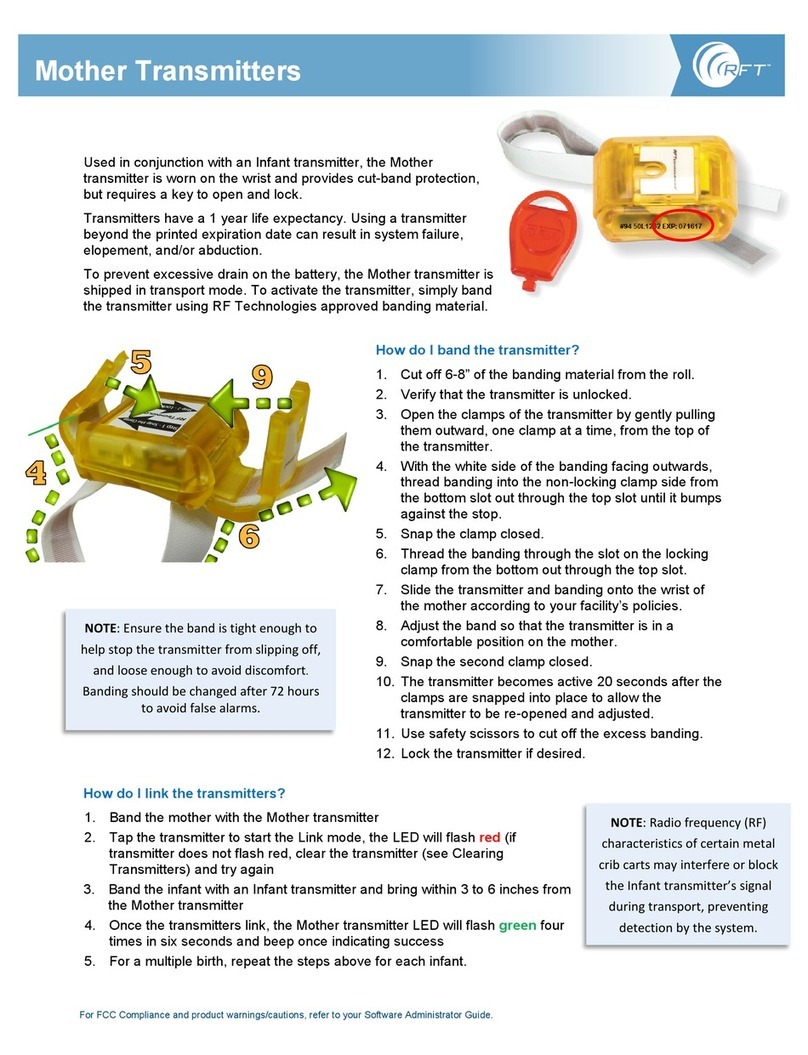
Rf-t
Rf-t Mother Transmitter manual

HYDACELECTRONIC
HYDACELECTRONIC HLT 2100 Series operating instructions

IEI Technology
IEI Technology Reporter PIR-300 manual

GEIGER
GEIGER Remote AIR GF2900 Original assembly and operating instructions
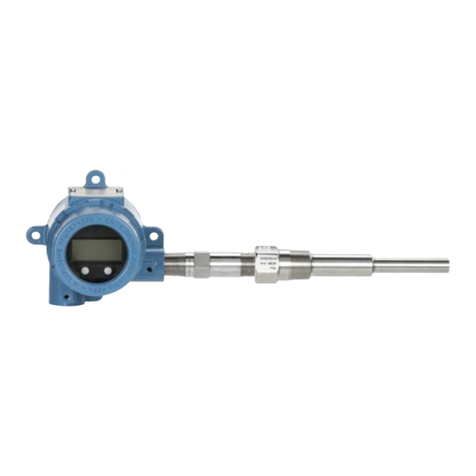
Emerson
Emerson Rosemount 644 Reference manual
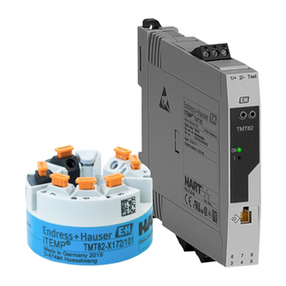
Endress+Hauser
Endress+Hauser iTEMP TMT82 operating instructions



